The brightest planets in May's night sky: How to see them (and when)
Unfortunately, the month of May is not a very good one for planet observers.
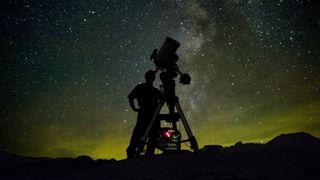
The month of May is not a very good one for planet observers.
The two brightest planets – Venus and Jupiter – are out of sight through this entire month because of their close proximity to the sun. Venus is in the midst of making a slow transition from the morning, into the evening sky and likely will not become available for viewing until sometime late in July or August, while Jupiter is shifting the other way – from the evening into the morning sky – and will probably not become evident through the dawn twilight until sometime during the second week of June.
Only two planets – Mars and Saturn – are somewhat easier targets. Mars continues to stubbornly lift up above the east-southeast horizon only at the break of dawn, while Saturn gradually rises earlier and appears against a progressively darker sky. The moon can be used to help identify both planets – Saturn on May 4 and again on the 31 and Mars on May 5.
Related: Night sky, May 2024: What you can see tonight [maps]
Read more: Best telescopes for seeing planets in 2024

Looking for a telescope to see the planets in August? We recommend the Celestron Astro Fi 102 as the top pick in our best beginner's telescope guide.
Mercury moves well out to the west of the sun during early May, and is very favorably placed for viewing in the morning sky, but only if you live somewhere south of the Tropic of Cancer. Indeed, for those who live south of the equator, Mercury will appear to literally soar high into the predawn eastern sky. But for most of us who live in temperate mid-northern latitudes, Mercury will always lie very close to the east-southeast horizon this month, while deeply immersed in the dawn twilight sky, making a naked-eye sighting difficult, if not impossible proposition.
In our schedule, remember that when measuring the angular separation between two celestial objects, your clenched fist held at arm's length measures roughly 10 degrees. Here, we present a schedule below which provides some of the best planet viewing times as well directing you as to where to look to see them.
Be sure to check out our best telescopes for viewing planets guide and our more general guides for the best binoculars and the best telescopes. If you're interested in taking your own impressive skywatching images, we have recommendations for the best cameras for astrophotography and the best lenses for astrophotography.
Mercury
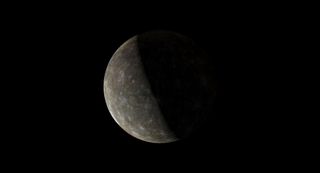
Mercury reaches greatest western elongation on May 9th. It is then 26-degrees from the sun, which is a larger angle than during the other three morning apparitions this year. Its brightness increases more than five-fold from magnitude +1.0 to -0.8 during May, yet only in the southern states do observers have a chance for a naked-eye sighting. This is due because of the low inclination of the ecliptic to the morning horizon, and because Mercury itself is 3-degrees south of the ecliptic. So, it never gets very high above the horizon for northern skywatchers. From the latitude of Mexico City southward to Antarctica, Mercury will rise before morning twilight begins.
Venus
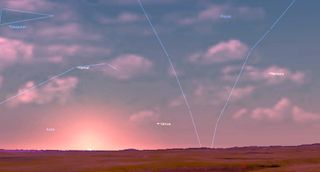
Venus is headed for superior conjunction on June 4 and is not visible at all in May.
Mars

Mars continues to rise right around the first sign of morning light, just as it has all year. Look for it low in the east as dawn brightens. It’s in the dull constellation of Pisces, so there will be no confusing it with any star. Its orange color helps identify it too. Mars will remain in the morning sky all summer and much of fall before sweeping by the Earth early next winter.
One day after its May 4 interaction with Saturn, you may attempt to make a sighting of an even thinner waning crescent moon on May 5, and if you're successful, you can also get a glimpse of Mars, positioned to its upper right.
Jupiter
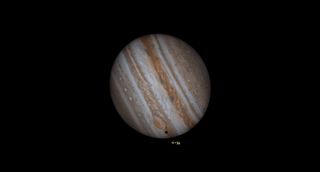
Jupiter is in conjunction behind the sun on May 18, and as a consequence, is not visible throughout this month. Even at month’s end it rises only about 25 minutes before the sun.
Saturn
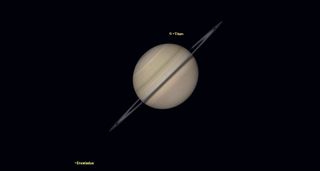
Saturn, in Aquarius, shines low in the southeast at dawn's first gleaming. It shines equally as bright as Fomalhaut which will be twinkling far down to its lower right. Although Saturn brightens slightly (to magnitude +1.1) during May, its rings will continue to narrow for another couple of months.
The first edgewise presentation of Saturn’s rings in a decade and a half is now less than a year away. Early on the morning of May 4, finds a slender waning crescent moon positioned roughly 6½-degrees to the lower left of the ringed planet. Then, on the morning of May 31, the moon pays Saturn another visit, though this will be a much closer approach compared to May 4. This time, the moon will slip just 1.2-degrees below the planet, which, as usual will appear as a bright, non-twinkling star shining with a sedate yellow color.
Joe Rao serves as an instructor and guest lecturer at New York's Hayden Planetarium. He writes about astronomy for Natural History magazine, the Farmers' Almanac and other publications.
Editor's Note: If you get a great photo of any of the planets and would like to share it with Space.com's readers, send your photo(s), comments, and your name and location to spacephotos@space.com.
Join our Space Forums to keep talking space on the latest missions, night sky and more! And if you have a news tip, correction or comment, let us know at: community@space.com.
Get the Space.com Newsletter
Breaking space news, the latest updates on rocket launches, skywatching events and more!

Joe Rao is Space.com's skywatching columnist, as well as a veteran meteorologist and eclipse chaser who also serves as an instructor and guest lecturer at New York's Hayden Planetarium. He writes about astronomy for Natural History magazine, the Farmers' Almanac and other publications. Joe is an 8-time Emmy-nominated meteorologist who served the Putnam Valley region of New York for over 21 years. You can find him on Twitter and YouTube tracking lunar and solar eclipses, meteor showers and more. To find out Joe's latest project, visit him on Twitter.
-
rod Good to see in the report Starry Night used for some charts. I use and enjoy very much in my stargazing as well as planet observations and asteroid tracking like 4 Vesta in Cetus now, moving retrograde. In my observation log (MS ACCESS DB), I load up views of the sky from Starry Night into my log entry along with various ephemeris generated that I import into Excel - works very well.Reply
